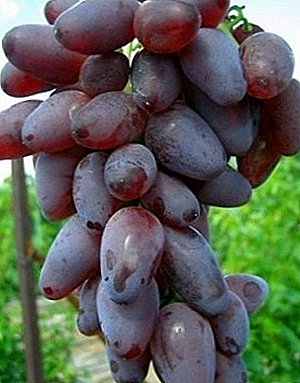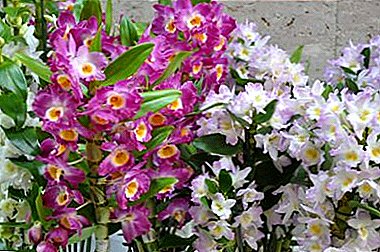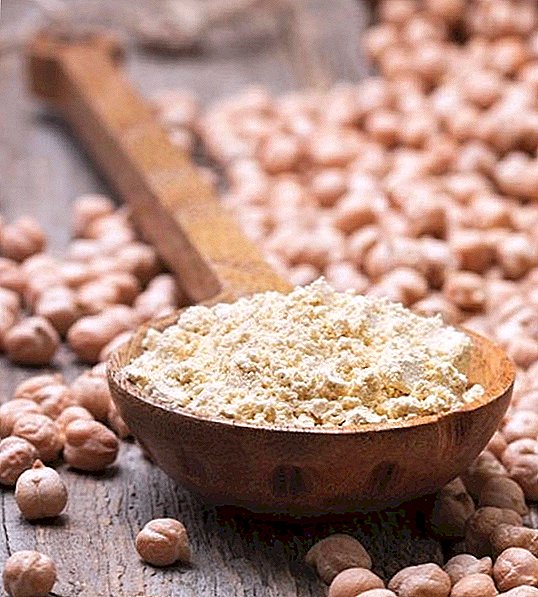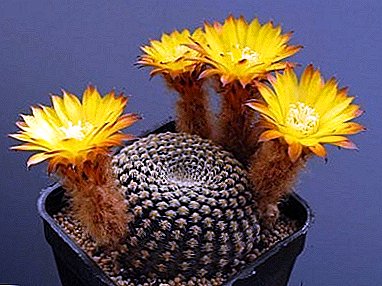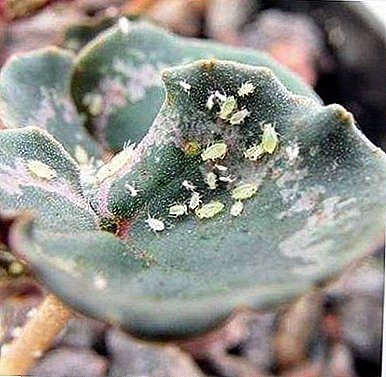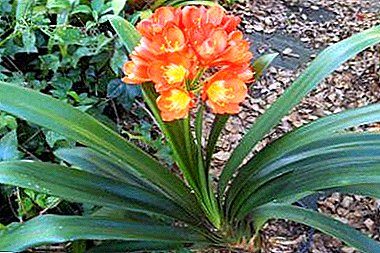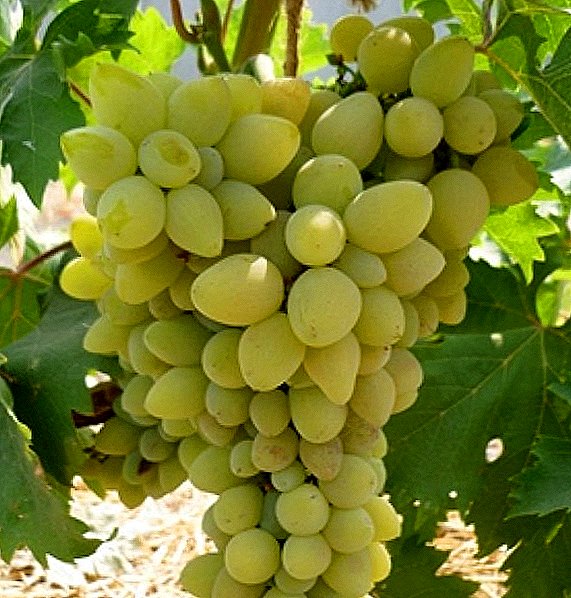
It is impossible to imagine a garden without a cherry - one of the most beloved fruit crops. In the spring - this is a cloud of delicate flowers, and in the summer - an abundance of delicious ripe berries.
Unfortunately, if earlier cherry yielded only apple in yield, then recently its fertility has fallen dramatically. New varieties are the hope of reviving generous and healthy cherry orchards.
In this article, we will focus on the new variety Novella - this cherry already has positive feedback from gardeners, for its unpretentiousness, a full description of the variety and the photo later in the article.
Breeding history and breeding region
 Novella - high-yielding, winter-hardy variety cherries, medium ripening, universal purpose.
Novella - high-yielding, winter-hardy variety cherries, medium ripening, universal purpose.
To universal varieties also belong Vyanok, Kharitonovskaya and Black Large.
It was obtained in Orel on the basis of the All-Russian Scientific Research Institute for Breeding Fruit Crops through hybridization of varieties Rossoshanskaya and Revival (has a gene resistant to coccomycosis, created by crossing the cherry with bird cherry).
Creators - famous breeders A. F. Kolesnikova and E. N. Dzhigadlo. In 2001, the cherry variety Novella was included in the State Register and recommended for cultivation in the Central Black Earth region.
Such varieties as Vavilov, Rovesnitsa, Tamaris and Fairy are also suitable for planting in this region.
Appearance of cherry Novella
Consider separately the appearance of the tree and fruit.
Tree
Cherry Novella - this is a medium-sized tree, about 3 meters high, with a round, sprawling, slightly raised crown. The bark on the trunk and skeletal branches - brown, on the shoots - brownish-brown.
Kidney small (about 4mm), slightly deviated, have an ovoid shape.
Leaflets matte, elastic, dark green. Their shape is obovate, with a pointed tip and a sharp base. The edges of the sheets with small oblique teeth.
 On the petiole and at the base of the leaf is one piece of iron.
On the petiole and at the base of the leaf is one piece of iron.
In the inflorescence of four flowers. The rim is free-fair, white. The stigma of the pistil and the anthers of the stamens are approximately at the same level.
The berries are tied on the bouquet branches and last year's shoots.
Fruit
The fruits of the Novels are maroon, almost black. The diameter of the ripe berries is about 2 cm, and the weight is about 5 g. The shape of the cherries is wide-round, slightly blunted.
The stone is yellow, round, perfectly separated from the pulp. Bone weight does not exceed 5% of the berry mass. The length of the stem is 3.8-4 cm, the berry comes off easily, the place of separation remains slightly damp.
Berries sour-sweet taste. The pulp density is medium, dark maroon color, the juice of berries is dark red. Fruits are perfectly transported and do not crack.
A photo




The main characteristics of the variety
In the Russian climate it is better to grow cherries frost-resistant, self-fertile, resistant to diseases. The right choice of varieties helps to preserve the crop and avoid difficulties in care. Non-capricious Novella already fell in love with gardeners.
Frost resistance is also demonstrated by the varieties Lyubskaya, Lebedyanskaya and Generous.
 Here are its advantages:
Here are its advantages:
- winter hardiness
- high yield
- resistance to coccomycosis and moniliasis
- excellent fruit quality
- relative short stature
- partial self-fertility
TIP: To attract bees for pollination, 1 tbsp. l Honey is dissolved in 1 liter of boiled water and sprayed with a solution of buds and flowers.
In the absence of pollinators, the partially self-fertile cherry variety Novella is capable of consistently bearing fruit. But it is better if pollinating varieties grow in the neighborhood.
As pollinators for Novella most suitable Shokoladnitsa, Vladimirskaya, Griot Ostheims.
Novella blooms in the second decade of May. Ripening occurs simultaneously in mid-July. The young tree comes into fruition in the fourth year.
 Under favorable weather conditions, the harvest from one adult tree is about 15 kg. In compliance with the norms of agrotechnology this variety is long-lived.
Under favorable weather conditions, the harvest from one adult tree is about 15 kg. In compliance with the norms of agrotechnology this variety is long-lived.
Among the shortcomings, it is necessary to note the average winter hardiness of flower buds. Return chills can deprive the grower of a future crop.
TIP: To delay flowering ground pristvolnogo circle cover with an additional layer of snow and mulch. Land under the crown will thaw longer, nutrients to the roots will come later, flowering will not fall under the frost.
Planting and care
Consider the rules of planting cherries Novella to avoid errors that can negate all the work.
Places with a high level of groundwater are contraindicated: lowlands, marginal marshes, low plains. But if the groundwater is located deeper than 2.5 meters, then dry summer will need watering.
This culture is quite demanding on the soil. The most suitable will be fertile with good air and moisture permeability. It is impossible to allow the thickening of cherry trees.
The lack of ventilation leads to an increase in humidity in the crown, which contributes to the proliferation of fungal spores. A distance of 3-4 m between trees will be optimal.

Soil mixture options:topsoil and compost or rotted manure (fresh manure can burn roots!) in a 1: 1 ratio
topsoil, humus and sand in a ratio of 0.5: 0.5: 1
To improve fruiting in the pit, you can add 1 kg of limestone or chalk, mixing it with the soil. It is also possible to add mineral fertilizers (superphosphate, potassium chloride or sulphate, wood ash) to the bottom of the pit, or to feed with the growth of the tree.
In the center of the planting pit dig a hole to the size of the root system and place the seedling there. Roots should be placed freely. Next to the seedling put the supporting peg for tying.
 After the roots are covered with earth, shaking the sapling so that all the voids are filled between the roots. When the roots are completely covered, the ground is gently trampled in a circle.
After the roots are covered with earth, shaking the sapling so that all the voids are filled between the roots. When the roots are completely covered, the ground is gently trampled in a circle.
After the earth should be shed properly to improve the contact of the roots with the soil. When the top layer dries - they loosen and mulch with a layer of dry soil.
ATTENTION! Recessed landing is contraindicated! This leads to a lack of growth and the oppressed view of the tree.
The first year of the trunk circle must always be kept hydrated and loosened regularly.
It is recommended to purchase annual saplings of about 70-80 cm in height, with mature wood and a developed root system.
If the seedling is more than one and a half meters high, and the bark is green, it means that it is obtained with a large amount of nitrogen fertilizer. Even a two-year-old cherry should not exceed 110 cm in height.
 If the planting material is crown, then leave the central shoot and 4-5 side branches, which are shortened by a third.
If the planting material is crown, then leave the central shoot and 4-5 side branches, which are shortened by a third.
The central shoot is cut so that it is 20 cm higher than the lateral ones.
And if the seedling is unbranched, it is cut 10 cm above the intended trunk. Below the pruning site, a minimum of 5 well developed kidneys should remain.
In April, the near-barking circle is mulched with rotted manure. Complex mineral fertilizers poured on the surface of the earth and buried in the soil.
In early spring and late autumn, the near-barrage circle is dug over with forks. Almost all the buds of a young tree are actively moving away in growth, which inevitably leads to crown thickening.
If you do not carry out pruning, it will lead to a decrease in yield. Therefore, all the strong branches growing inside the crown, cut out. You need to form the crown so that no more than 10 main branches are left. Tree cherry branches can be shortened without fear.
Diseases and pests
 Novella resistant to diseases, which is popularly called "cherry plague" - coccomicosis and moniliasis.
Novella resistant to diseases, which is popularly called "cherry plague" - coccomicosis and moniliasis.
Signs of moniliosis are lifelessly hung tips of young shoots and brown leaves.
Coccomycosis occurs as a spot on the leaves.
Fortunately, Novella is affected by these diseases rarely and locally. At detection of diseases affected branches must be cut and burned.
Since the source of the primary infection are fallen leaves, in order to prevent them, it is better to burn them until the fall.
During the growing season, for the prevention of diseases, plants can be treated with a 1% solution of Bordeaux mixture or 0.3% chlorine dioxide (30 g of the drug per 10 liters of water).
Zhukovskaya, Mayak, Malinovka and Podbelskaya can boast of special resistance to coccomycosis.
One-sided ugly berries - a sign that the cherry is chosen by the most passionate fan of this culture - cherry weevil - A small bug with a long trunk. He is very careful, when a person approaches, he instantly falls into the grass.
 Winter spends in the ground, and in early spring is populated by trees. Eats buds, buds, flowers, leaves, ovaries.
Winter spends in the ground, and in early spring is populated by trees. Eats buds, buds, flowers, leaves, ovaries.
In the ovary weevil eats holes or eats them completely. The larvae, gnawing through the holes in the bones, feed on the nucleus.
Ways of struggle:
- It is necessary to collect windfalls every day, then the larvae will not have time to go to the ground.
- When harvesting at the bottom of the container you need to put a cloth, leave the fruits for the night, accumulated at the bottom of the larvae to destroy.
- The bones of the eaten affected cherries should be burned.
- In order to reduce the pest population, it is necessary to dig in the spring and autumn and loosen the trunk circle in spring and autumn.
- 1.5 kg of tomato tops pour a bucket of water and boil for half an hour. Cool the solution and add 40 g of soap, strain and spray the trees.
- 350 g of wormwood chop and pour a bucket of water. Insist for 24 hours, boil for half an hour, add 40 g of soap, strain and spray the trees.
- In addition to cherry weevil, other pests also attack: cherry fly, sprout moth, sawflies, trubkoverty. It is necessary to fight them with the help of insecticides according to the instructions.
Folk remedies for cherry weevil:
 The basis of a healthy productive cherry orchard is the correct selection of varieties.
The basis of a healthy productive cherry orchard is the correct selection of varieties.
Those who have already tested Novella in their gardens have not been disappointed in the result.
With proper care, the variety delivers a minimum of hassle and pleases gardeners with a generous harvest.



